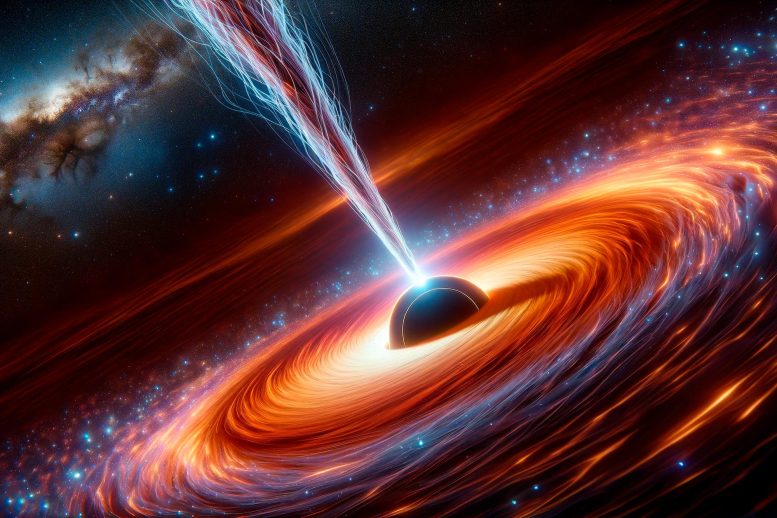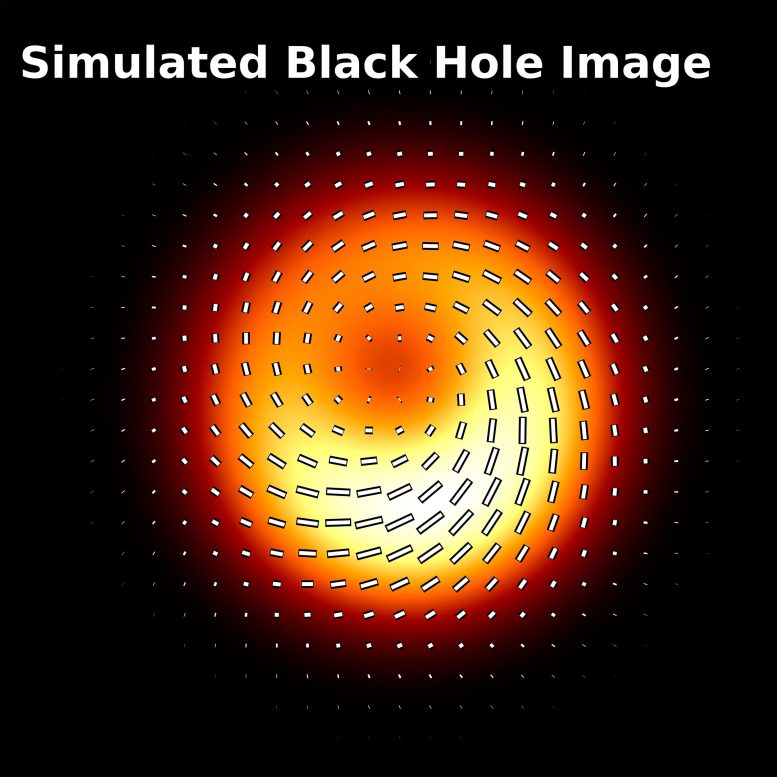
Princeton researchers have found that the M87* black hole expels energy outward, contributing to the formation of massive jets. This discovery, rooted in Einstein’s theory of relativity, challenges traditional views of black holes and could be further tested with advanced telescopes. The study opens new avenues in understanding black hole dynamics, though it stops short of definitively explaining the source of the jets’ power. Credit: SciTechDaily.com
A team of Princeton astrophysicists has now determined conclusively that energy close to black hole M87* is pushing outward, not inward, a longstanding debate within the field.
The one thing everyone knows about black holes is that absolutely everything nearby gets sucked into them.
Almost everything, it turns out.
“Even though black holes are defined as objects from which nothing can escape, one of the astonishing predictions of Einstein’s theory of relativity is that black holes can actually lose energy,” says astrophysicist Eliot Quataert, Princeton’s Charles A. Young Professor of Astronomy on the Class of 1897 Foundation. “They can rotate, and just like a spinning top slows down over time and loses that energy in its rotation, a rotating black hole can also lose energy to its surroundings.”
Scientists have widely accepted this model since the 1970s. They knew that magnetic fields probably extract energy from spinning black holes — they just didn’t know how.
A team of Princeton astrophysicists has now determined conclusively that energy close to the event horizon of black hole M87* is pushing outward, not inward. (M87 is the name of the galaxy, Messier 87, so the black hole at its center is designated M87*.) The researchers have also created a way to test the prediction that black holes lose rotational energy, Quataert said, and to establish it’s that energy that produces “the incredibly powerful outflows we see that we call jets.”
An animation showing how the magnetic field crossing the black hole’s event horizon twists up as as the black hole rotates more quickly. A faster-rotating black hole `winds up’ the magnetic field more quickly, causing the black hole to lose more energy to its surroundings. A team of Princeton astrophysicists observed the wind-up of magnetic field lines in images from the Event Horizon Telescope of the linear polarization from black holes. Credit: Video by George Wong, Institute for Advanced Study and Princeton University
These energy outflow jets “are basically like million-light-year-long Jedi lightsabers,” said former Princeton postdoc Alexandru Lupsasca, and they can extend 10 times longer than the Milky Way galaxy.
The results of their work were recently published in The Astrophysical Journal. Andrew Chael, an associate research scholar in astrophysics, is the first author on the paper. He and co-author George Wong are both members of the Event Horizon Telescope team and have played a critical role in developing the models that are used to interpret black holes. Chael, Wong, Lupsasca and Quataert are all theorists affiliated with the Princeton Gravity Initiative.
The team gave Chael credit for the vital insight at the core of the new paper: that the direction in which the magnetic field lines are spiraling reveals the direction of the energy flow. From that, “the rest sort of fell into place,” Quataert said.

The black hole M87* (the asterisk designates the black hole in the middle of galaxy M87) caught the world’s attention when it was first detected by the Event Horizon Telescope. Since then, Princeton astrophysicists have discovered that the twisting magnetic field around a black hole determines the tell-tale polarization spiral observed in black hole images. In particular, the direction of energy flow (from the hole to the field or vice versa) determines the how the polarization twists. By measuring which way the polarization spirals, one can infer whether the magnetic field is extracting spin energy from the hole or pumping spin energy into it. Credit: Model by Andrew Chael, George Wong, Alexandru Lupsasca and Eliot Quataert, Princeton Gravity Initiative
“If you took the Earth, turned it all into TNT and blew it up 1,000 times a second for millions and millions of years, that’s the amount of energy that we’re getting out of M87,” said Wong, an associate research scholar with the Princeton Gravity Initiative and a member of the Institute for Advanced Study.
Scientists have known for decades that as a black hole starts to spin, it drags the fabric of spacetime around with it. Magnetic field lines that thread through the black hole get dragged along, and that slows down the rotation, leading to the energy release.
“Our new, sharp prediction is that whenever you look at an astrophysical black hole, if it has magnetic field lines attached to it, there will be energy transfer — truly insane amounts of energy transfer,” said Lupsasca, a former associate research scholar at Princeton who is now an assistant professor of physics and mathematics at Vanderbilt University, and who won the 2024 New Horizons in Physics Prize from the Breakthrough Prize Foundation for his black hole research.
While the energy flow close to M87*’s event horizon is streaming outwards, the team said that the energy flow could theoretically go inward in a different black hole. They are confident in their link between energy flow and the direction of the magnetic field lines, and their prediction that the energy flow comes from the black hole will be tested with the launch of the still-theoretical “next generation” Event Horizon Telescope.
For the past year and a half, black hole researchers around the world have been proposing specs for the future instrument, Wong said. “Papers like ours can play a crucial role in determining what we need. I think it’s an incredibly exciting time.”
The four researchers stressed in their paper that they haven’t conclusively shown that the black hole’s spin “truly powers the extragalactic jet,” though the evidence certainly leans in that direction. Even though the levels of energy that their model shows are commensurate with what the jets need, they couldn’t rule out the possibility that the jet could be powered by rotating plasma outside the black hole. “I think it’s extremely likely the black hole powers the jet, but we can’t prove it,” said Lupsasca. “Yet.”
Reference: “Black Hole Polarimetry I. A Signature of Electromagnetic Energy Extraction” by Andrew Chael, Alexandru Lupsasca, George N. Wong and Eliot Quataert, 14 November 2023, The Astrophysical Journal.
DOI: 10.3847/1538-4357/acf92d
The research was supported by the Princeton Gravity Initiative, the Taplin Fellowship, the National Science Foundation (grant 2307888) and a Simons Foundation Investigator award.









This was written for me to understand. I don’t, but that’s alright, as it sounds like nobody really understands how these jets are created. Astrophysical jets are just beautiful. The energy, which Princeton and authors Chael & Lupsasca & Wong & Quataert found is actually escaping the black hole, boggles the mind, not to mention the energy that isn’t escaping. The quotes, with “million-light-year-long Jedi lightsabers”, and the Earth made of TNT exploding every second, I can just sense the fun the astrophysicists are having trying to conceptualize and explain it.
I’m not an astrophysicist, and the full-text-available study is beyond me, meaning I can’t really speak to the veracity of the finding. Props to Liz Fuller-Wright on a well written press release. That was great, from the explanations, to the quotes, to shaping the quotes with the “yet” at the end. The whole article left me feeling optimistic and wanting to learn more. We’ll know someday, and maybe go check it in person.
Fantastic approach to life and learning.
Thank you AG3. It’s a difficult world lately to keep an approach like that up, but I hope it’s a winning way. The massive energy transfer away from the black hole, versus what I learned about Hawking radiation, yet this jet is only described as originating maybe “close to the event horizon”, basically I’m confused. Hopefully the Next Generation Event Horizon Telescope (ngEHT) can clear it up, and I enjoy the goofy names of the new big telescopes, like the ELT (Extremely Large Telescope). I suggest the next one be called the RRBT, the Really Really Big Telescope.
I enjoy well written articles, sometimes beyond the content. Many are dumbed-down so far as to be false, or so badly written as to oppose the foundations of the very field of science the study was in. We should expect a communications writer at Princeton to do well, but there’s some kind of competency crisis happening lately. This article’s topic is something so obscure and distant and confusing and unimaginable, explained so well in a relatable fun way. Maybe an astrophysicist can comment if it was all rubbish, but it sounds fair, with no absurd claims, no cheap tricks, like how it could be dangerous or confirms someone’s agenda. I’m harshly and glibly critical of bad writing I see on SciTechDaily, and I feel bad about that while trying to bring back a scientific criticism approach to interpreting articles, so it was a joy to see excellent writing about the progress in our understanding of the universe.
Rotation of galaxy is a theory(though Law),and can not be measured by experiment.Rotation of supermassive black hole is equal to the rotation of star(s).So,all measured value found in this experiment are exact;without any excuse,so,good and thanks for binary jets due to supermassive black hole and stars separately.Values consistent with Star Dynamics.From the Galaxy Dynamics of Rotation,ĺink of M87 jet with òthers(galaxies) can be determined;as this is done here for our own galaxy milky way through star,the sun.
Please stop commenting on stuff you don’t understand. We can’t measure the rotational velocity of a black hole, but we can measure the rotational velocity of the accretion disk around it using Doppler shift of emitted light. No need for stars.
“Rotation of galaxy is a theory(though Law)…” – what the actual f*** are you babbling about?
Ever wonder why (and how) supermassive Black Holes expel jets of anything rather than sucking them in? One view of String Theory suggests that active galaxies, including radio galaxies, Seyfert galaxies, and Quasars, may be explained with branes (dimensional membranes) at their centers rather than Black Holes. This view also explains those curious low surface brightness galaxies like Malin 1. Specifics on this can be found by searching YouTube for “Active Galaxies – A String Theory Way”
I don’t wonder, because black holes don’t expel jets of matter – the accretion disk does. Nothing comes out from inside the event horizon. Hopefully, this fixes one of the education gaps in your Ph.D.